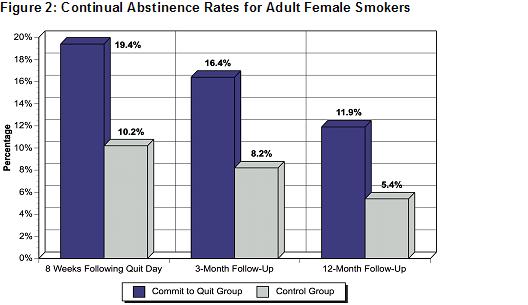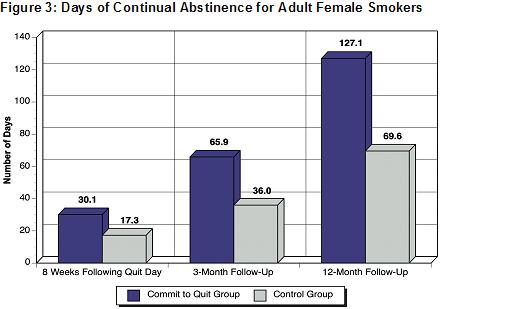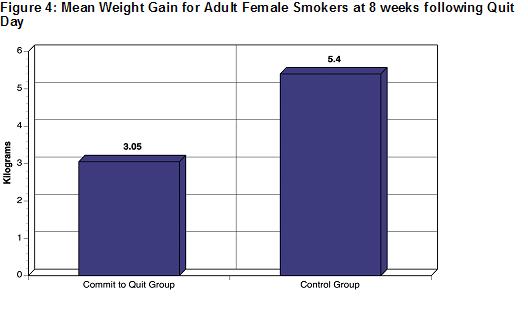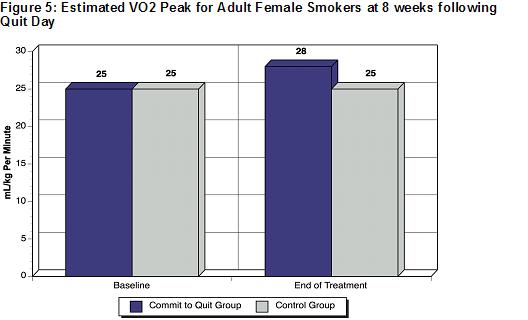The Implementation Guide is a resource for implementing this evidence-based program. It provides important information about the staffing and functions necessary for administering this program in the user's setting. Additionally, the steps needed to carry out the program, relevant program materials, and information for evaluating the program are included. The Implementation Guide can be viewed and downloaded on the Program Materials page.
Program Synopsis
Designed to increase vigorous-intensity physical activity and promote smoking cessation among women, this intervention includes a group-based smoking cessation program and a tailored exercise regimen. The study showed higher abstinence rates, less weight gain, and increased physical activity.
Program Highlights
Program Materials
Preview and order the materials from the developer
Implementation Guide
Download Implementation Guide
Program Scores
The Need
Tobacco dependence continues to be the leading, preventable cause of cancer, coronary heart disease, emphysema, respiratory infections, and bronchitis. Although smoking prevalence rates are declining for both women and men, the decline is slower for women. One reason is that while men and women have similar quit rates, men are able to refrain from tobacco use for longer periods. This has prompted requests for smoking cessation programs designed specifically for women. Variables such as concerns about weight gain, the belief that smoking reduces stress, and the need for social support have been identified as particularly relevant to smoking cessation programs for women. Participation in regular, vigorous physical exercise may be an alternative to smoking that may aid cessation efforts among female smokers. Exercise may address psychosocial and physiological needs that cannot be achieved with nicotine replacement therapy alone.
The Program
Geared toward adult female smokers, Commit to Quit is a 12-session, group-based, cognitive-behavioral smoking cessation program and exercise regimen tailored specifically to each participant. The cognitive-behavioral program includes traditional topics: self-monitoring, stimulus control, coping with cravings and high-risk situations, stress management, and relaxation techniques. Also included are topics of particular importance to women: healthy eating, weight management, mood management, and balancing work and family. The exercise component involves attending three exercise sessions per week. Exercise sessions consist of a 5-minute warm-up, 30-40 minutes of aerobics, and a 5-minute cool-down with stretching. Each person is given an exercise prescription calculated from the peak heart rate achieved on a baseline exercise test.
Community Preventive Services Task Force Finding
 This program uses an intervention approach recommended by the Community Preventive Services Task Force: individually-adapted health behavior change programs (Physical Activity).
This program uses an intervention approach recommended by the Community Preventive Services Task Force: individually-adapted health behavior change programs (Physical Activity).
Time Required
The program requires 12 weeks to implement. Participants attend the group-based, cognitive-behavioral smoking cessation program once per week and three 40-50 minute exercise sessions per week.
Intended Audience
The intended audience for the Commit to Quit program is adult female smokers.
Suitable Settings
The program is suitable for implementation wherever group-based smoking cessation treatment is offered and at exercise facilities.
Required Resources
The materials required for this program are the Commit to Quit Patient Manual, the Commit to Quit Leader's Manual, and the Commit to Quit Exercise Protocol. It is recommended that leaders of the cognitive-behavioral program have a background in health promotion and wellness and that exercise staff have an exercise science degree.
About the Study
Participants took part in a randomized controlled clinical trial to assess the efficacy of cognitive behavioral therapy and vigorous aerobic exercise in promoting smoking cessation, improving exercise performance, and reducing weight gain. All treatment and control subjects participated in a 12-week, group-based, cognitive-behavioral smoking cessation program. Participants in the Commit to Quit group were also required to attend three exercise sessions per week, including one supervised session per week on their smoking cessation treatment night. Participants in the contact control condition also participated in a 12-week wellness program, attending three 45-60 minute supervised sessions per week, consisting of lectures, handouts, films, and discussions addressing women's health and lifestyle issues.
The sample was composed of 281 healthy sedentary women aged 18-65 years (mean age 40.7 for the Commit to Quit group, 39.7 for the control group) who had regularly smoked 10 or more cigarettes a day for at least 3 years and who had exercised less than twice a week for at least 6 months.
Exercise performance was measured prior to randomization and after 12 weeks of treatment. A graded maximal exercise test was performed on a stationary bike to measure functional capacity, expressed as estimated peak oxygen consumption per unit time (VO2). Cigarette smoking abstinence was measured by self-report questionnaire. Seven-day point prevalence abstinence (PPA) was obtained weekly during the 12-week program and 3 and 12 months after treatment. Continuous abstinence from quit day (week 4) to end of treatment (8 weeks later) and 3 and 12 months after treatment was also evaluated to examine sustained cessation, which relates more directly to health outcomes than 7-day PPA. Weight gain was defined as change in weight from baseline to the assessment period.
Key Findings
Effects of the Commit to Quit Program on Cigarette Smoking Abstinence
- At the 3-month follow-up, 24.6% of Commit to Quit subjects had not smoked for the previous 7 days, as opposed to 13.6% of control subjects (p=.02). This difference did not hold at the 12-month follow-up.

- Commit to Quit subjects were significantly more likely than control subjects to be continuously abstinent during the 8 weeks of treatment following quit day (19.4% versus 10.2%, p=.03), at the 3-month follow-up (16.4% versus 8.2%, p=.03, and at the 12-month follow-up (11.9% versus 5.4%, p=.05).

- Commit to Quit subjects achieved significantly more days of continuous abstinence than control subjects at the end of treatment (mean+SD, 30.1+26.4 versus 17.3+22.4 days, p<.01), at 3-month follow-up (65.9+69.4 versus 36.0+56.6 days, p<.01), and at 12-month follow-up (127.1+164.1 versus 69.6+130.9 days, p<.01).

- Compared with control subjects, Commit to Quit subjects were 35% less likely to have relapsed at the end of treatment (p<.01), 34% less likely to have relapsed 3 months after treatment (p=.01), and 36% less likely to have relapsed 12 months after treatment (p=.03).
Effects of the Commit to Quit Program on Weight Gain
- Among quitters, Commit to Quit subjects had gained significantly less weight than control subjects at the end of treatment (mean+SD, 3.05+3.45 versus 5.40+6.94 kg; p=.03). This treatment effect did not hold for the two follow-up periods.

Effects of the Commit to Quit Program on Exercise Performance
- Among those attending the post-treatment exercise assessment, the estimated VO2 peak increased significantly with training in the Commit to Quit subjects (mean+SD, 25+6 mL/kg per minute at baseline, 28+6 mL/kg per minute at end of treatment; p<.01) but was unchanged in the control subjects (25+4 mL/kg per minute at baseline, 25+5 mL/kg per minute at end of treatment; ns).



